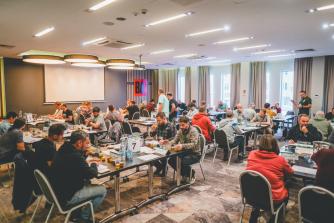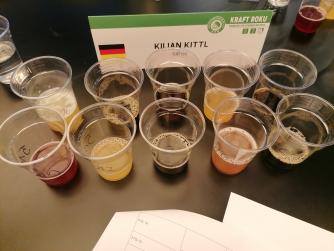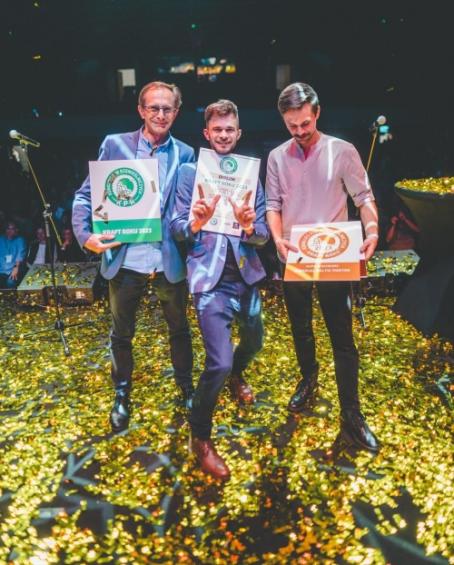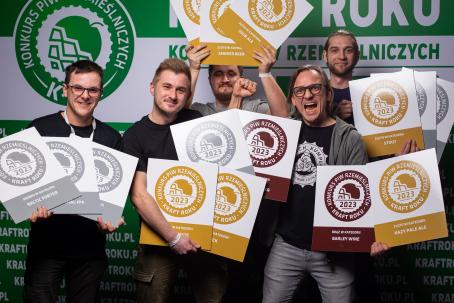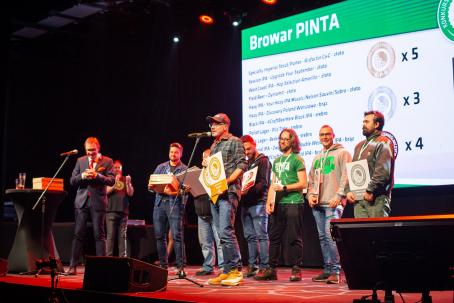Kraft Roku und Sympozjum Piwowarów
Tasting pictures by Mateusz Włoch, Pictures from the awards ceremony by Kacper Marczukiewicz
The first entry of the travel blog takes us to the neighboring country of Germany - to Poland. To be more precise: to Krakow.
The national Kraft Roku tasting competition took place there for the 16th time from December 10 to 13, 2023. With 810 beers from 121 Polish breweries, Kraft Roku is the largest beer tasting competition in Poland and is an excellent representation of the Polish beer landscape. The tasting is organized by Browamator (www.browamator.pl). The tasting was immediately followed by two days of technical presentations at the Sympozjum Piwowarów. The symposium was organized by the Polskie Stowarzyszenie Browarów Rzemieślniczych (PSBR, Polish Craft Beer Association; www.psbr.eu). The culmination of the symposium will be the award ceremony for the competition and the presentation of the Kraft Roku (Craft Beer of the year) award.
The Polish beer market is characterized by similar trends to those in Germany. Marek Kaminski, President of the PSBR, summarized the current situation during BrauBeviale as follows:
The Polish beer market is also facing declining per capita consumption. While consumers are adventurous when it comes to beer and are trying out new, innovative beers, the trend - as throughout Europe - is also moving towards light and non-alcoholic beers, says Kaminski.
Market developments in Poland:
- Rise of craft brewers as a key trend - consumer demand for high quality and regionality
- Rising trend for low-alcohol and alcohol-free beers - Conscious nutrition and desire for healthy products among consumers
- Development of a lively beer culture in Poland - growing reputation of small breweries among consumers. Reference point for quality beers
Poland is particularly proud of its typical beer styles. The Baltic Porter (new category at the European Beer Star 2024) and the Grodziskie (also known as Grätzer in German-speaking countries), which was tasted for the first time at the European Beer Star in 2023. A portrait of the beer style was published in the eighth edition of Beer Star News. Learn more about Grodziskie
Konkurs Piw Rzemieslniczych - Polish Craft Beer Competition
To get everyone in the mood for the tasting days, a welcome event was held at the House of Beer Multitap in Krakow the evening before the tasting. In a convivial atmosphere and with good food, all the guests started the next two tasting days in a good mood.
On December 10 in the morning, the time had come. 46 tasters (50% national and 50% international) from 13 countries were looking for the best Polish beers of 2023. The tasting venue was the Novotel West in Krakow, which provided ideal conditions for the judges. The beers forthe next flightt were determined in tournament mode. After each round, each team of four was able to send the 3 best beers from each round to the next round, until the 3 medal winners were chosen in the final. Naturally, the beers were tasted blind.
Each team was allowed to taste 7 flights per day. The number of samples varied up to 10 samples. As a German taster, you are often asked about your expertise in German beer styles at international competitions. This was of course also the case here, although it must be praised that the mixture of many beer styles was given to all judges. The appeal of international tastings for the judges is always the local beer styles. And the judges were not disappointed!
The first tasting day started with a German-style Pilsner. In the preliminary rounds, the judges always get to taste the entire spectrum of beers. From very good representatives to obvious off-flavors, everything can be there. For a German consumer, the pilsner beers came across as relatively dark in golden yellow. In addition to oxidized (aged) beers, there were also beers containing diacetyl. All in all, however, a decent first round of Pils.
Surpreme Discipline Baltic Porter
The final round of Baltic Porter awaited the tasting table on the very first day. The home of the beer style did not promise too much. An excellent round. The discussion with the Polish tasters was very enlightening. A noble oxidation (notes of dried fruit, raisins, plums, cherries but also sherry notes) is permitted and even desirable in these beers. Drinkability is of great importance. As the author was able to determine, the taste can go as far as soy sauce in extreme cases, although this is not a desired flavor impression. The exchange between the international and local beer community is what makes these trips so appealing. You only get to know the beer styles of the world in your home country. Valuable insights that are then also incorporated into the European Beer Star. After a break of two years, the Baltic Porter will be tasted again at EBS 2024.
Category description Baltic Porter
original source: https://kompendiumpiwa.pl/porter-baltycki/
Parameters:
Initial extract: 18-22 °P
Final extract: 4-6 °P
Alcohol content: 8-10% abv.
Bitterness: 25-45 IBU
Color: 45-75 EBC
A strong, rich, dark lager traditionally produced in the Baltic States.
Style hallmarks:
A strong, dense, succulent dark lager, whose flavor and aroma is created by a combination of rich maltiness, notes of dried fruits, restrained roasted accents and low notes of refined alcohol. It is distinguished from stouts of similar strength by a lower level of aromas derived from roasted malts, a generally fuller palette of malt flavors and a cleaner, lager profile. A tasting beer, slightly warming, predestined for unhurried contemplation.
Aroma:
Medium to high, complex malt aromas: sweet, caramel, roasted caramel, cookie, toasted bread crust, wholemeal bread, dark malt cake, nuts. Medium-low to high notes of ripe or dried fruits such as cherries, plums, cherries or raisins are desirable. The fruitiness should come from the malt, oxidation or a combination thereof, and not from the yeast work. Evidently yeasty esteriness, such as that of banana (isoamyl acetate) or red apple (ethyl hexanoate) is a defect. In the best examples, oxidation is also manifested by aromas of fortified (liqueur) wines, such as sherry, port or Madeira, at low to medium levels. Oxidized notes should not dominate the bouquet. The whole is complemented by low to medium-high roasted malt aromas, mostly chocolate, sometimes licorice or slightly coffee-like. However, they are never as intense as in stouts. A low, refined alcohol note is acceptable, but it must not be solvent or fuselike (higher alcohols). Hop aroma is absent.
Taste:
Medium to high, complex malt flavors: sweet, caramel, roasted caramel, cookie, toasted bread crust, wholemeal bread, dark malt cake, nuts. Medium-low to high notes of ripe or dried fruits such as cherries, plums, cherries or raisins are desirable. The fruitiness should come from the malt, oxidation or a combination thereof, and not from the yeast work. Evidently yeasty esteriness, such as that of banana (isoamyl acetate) or red apple (ethyl hexanoate) is a defect. In the best examples, oxidation also manifests itself with flavors of fortified (liqueur) wines, such as sherry, port or Madeira, at low to medium levels. Oxidized notes should not dominate the taste. The whole is complemented by low to medium-high aftertastes of roasted malts, chocolate, sometimes licorice or slightly coffee-like. However, they should not have a heavily roasted character, ash or burnt, nor should they be as high in intensity as in stouts. There is usually a low, refined alcohol note, but it should not be overly pronounced, nor should it have a solvent or fuselic (higher alcohols) character. Elevated acidity is undesirable. Hop flavor is absent. The balance of the beer is malty. The taste is initially sweet, becoming more dry in the finish, preventing a bland, cloying sensation. Ports with both a slightly sweet and more dry finish are acceptable.
Bitterness:
Medium to medium, coming from both roasted malts, hops and alcohol, but this aspect must not be dominant. The bitterness should not come to the forefront, but only provide a counter to the maltiness and build a drier finish.
Appearance:
Dark brown, brown to almost black color. Frequent brown or maroon, ruby-red highlights. Clarity. Foam of light beige to brown color. Dense, fine, low to medium, may be moderately persistent.
Mouthfeel:
Tartness medium-high to high. The beer is smooth and somewhat creamy. Saturation is low to medium. There may be an alcoholic warming, but it should not dominate the beer or have a solvent character, but the elegant character of an aged distillate. Rough or astringent sensations are undesirable.
Raw materials and technology:
The base is usually Munich or Vienna malt, sometimes with an admixture of Pilsner malt. A variety of caramel malts with a fairly wide color spectrum are used, as well as roasted malts. However, the latter should be used in moderation, preferably in a de-hulled version to avoid intrusive roasted flavors. Traditional continental hops, used mainly for bitterness. Bottom-fermenting yeast. The beer benefits from long aging under optimal conditions.
The second day also began bottom-fermented with Bohemian-Stlye Lager. Vycepnyi (Czech light beers) were also included in this category. Contrary to popular belief, diacetyl is not supposed to be dominant in Bohemian Lager, but only to support the full-bodied flavor. In terms of taste, it should not be noticeable at all. Another good start to the day.
After smaller flights of Black IPA and Other IPA (Rye IPA, Rice IPA, Brut IPA,...), our team was served 10 different stouts. The high quality impressed the jury, even if the comparison between excellent dry stouts and oatmeal stouts is often difficult for the jury to assess due to their different characteristics. Nevertheless, the table quickly agreed on 3 finalists.
The enormous variety of Baltic Porters then became clear once again in the final rounds of the second day. There were two separate categories in the competition for wood barrel-aged Baltic Porter and for Specialty Baltic Porter. The highlight was a Baltic Porter matured with a spiral of Amburana wood. Amburana is a tropical wood with a high coumarin content. The taste is strongly reminiscent of tonka bean. A very successful experiment that was rightly rewarded with gold in this category.
The Specialty Baltic Porters in the final were characterized by the addition of smoked plums (very popular in Poland) or the use of smoked malt (beech and/or cherry wood-dried). A worthy conclusion to two all-round successful tasting days.
Of course, a joint picture of the tasters was a must. Mandatory at international beer tasting competitions.
Awards Ceremony and Conclusion
The stylish award ceremony took place as the closing event of the Sympozjum Piwowarów. 140 medals were awarded in 49 categories. If you would like to see the award ceremony for yourself, you can watch the stream on YouTube.
The beer of the year (Kraft Roku) was chosen by a select panel of tasters after the regular tasting. All gold medal beers were tasted again. The jury's task was to taste the gold medal beers again and determine the beer of the year. On the one hand, this was a very enjoyable task (because you get to taste the best beers of the competition in one go), but also a demanding responsibility for the judges.
The beer of the year was the Latający Jeleń in the Imperial Baltic Porter category (another Baltic Porter category) from Browar Kazimierz.
The most successful breweries in Poland in 2023 were Browar Trzech Kumpli and Browar Pinta. At the European Beer Star 2023, Trzech Kumpli won silver in the Strong Porter category with its Smoked Baltic Porter. No wonder, given the high quality of Polish beers.
The brewing landscape in Poland is facing challenges, but is alive and kicking! The high quality of the beers is an indication of the passion and skill of Polish breweries. Congratulations to all the winners of Kraft Roku 2023! The author is certain that several medals will go to Poland at the European Beer Star 2024. Not only for Baltic Porter and Grodziskie.
Kilian Kittl





